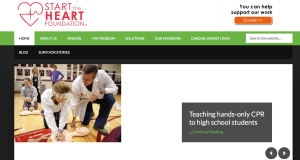What is the greatest possible thing that could happen to you today?
Is it winning a million dollars? Seeing your children smile? Going to a job you love? Perhaps it is waking up next to a spouse whom you love and is also your best friend?
These are all winners, for sure.
But what if you actually saved another person’s life? No, not figuratively, but really. Imagine: another person just up and dies in front of you, and you take decisive action to save her. And she lives.
I can testify that truly saving a life is indeed a life-changer. You never forget.
The scenario of out-of-hospital cardiac arrest is not an uncommon one. Heart disease is the number one killer of people in the Western world, and sudden death from cardiac arrest is the leading way people die from heart disease. Most people who suffer cardiac arrest have had no prior warning of heart disease. That’s right; you just amble on as a normal day and then fall over into nothingness.
Here is where we depend on each other.
The only chance a person who suffers cardiac arrest has is immediate and decisive action from a fellow human: calling 911, effective bystander CPR and then prompt defibrillation.
My medium-sized American city, Louisville, Kentucky, has a dismal survival rate from cardiac arrest. If you die suddenly here, there is a greater than 90% chance you will not survive. Contrast this with Seattle WA or Rochester MN, which both boast survival rates of 50%.
What’s the difference? It’s about community awareness and education. Studies from Europe that look at adjoining counties have shown similar disparities in outcomes of cardiac arrest. The counties with CPR awareness campaigns and greater density of AEDs have much higher survival rates from cardiac arrest.
We depend on each other.
Another amazing fact: most cardiac arrest occurs in the home, so people who learn hands-only CPR most often use it on a loved one—not a stranger.
My partner, Dr. William Dillon, an interventional cardiologist, has made it his midlife mission to improve cardiac arrest survival rates in Louisville. And he’s doing it in an unusual way—one that harkens back to the proverb ab out teaching a man to fish.
out teaching a man to fish.
The Start the Heart Foundation (STHF) is a non-profit organization (disclosure: I am a board member) that aims to improve cardiac arrest survival here in Louisville. Dr. Dillon’s idea and plan, which is already in full swing, is to use pre-medical students to go out into the community to teach hands-only CPR. The other novel idea that STHF uses is to focus in the areas most affected by cardiac arrest—which, in Louisville, are the under-served west and south end of town. “Go where the action is,†says Dr. Dillon.
As the last post on the STHF blog says, “we will teach anyone hands-only CPR.â€
I ask you to consider doing a couple of things:
One is to spread the word about hands-only (no mouth-to-mouth) CPR, how easy is it is to learn, how easy it is to do, and how influential community awareness can be in improving the chances of surviving cardiac arrest.
The other thing I ask you to consider doing is to read this short but poignant post from one of the young Start the Heart Foundation interns, Amna Zoji. She writes about her personal experience with her father’s death, and what it means to her to teach a skill that could some day prevent a scar in someone’s memory. Maybe even consider sharing the beautiful story. (You are not surprised that STHF interns are encouraged to write and participate in social media, are you?)
If you are a local reader here in Louisville, please consider contacting Start the Heart Foundation to set up a visit from the interns to teach your team or business or church hands-only CPR. It’s free!
Look for more from me on this important venture in the future.
JMM
Start the Heart Foundation Twitter – @StarttheHeart2
Dr. William Dillon Twitter — @wmdillon
3 replies on “We depend on each other…”
Just a thought for the non-medical minority here. If there is an AED in sight, don’t be afraid to use it. It has simple instructions on it’s use in the case and won’t fire if the person isn’t in a deadly arrhythmia. You can’t possibly do any harm, the person is dead without it.
Great timely and public spirited post as usual, John!
We have been teaching CPR for over 40 years. The first JAMA supplement on CPR standards was published in February 1974. The Seattle experience was beginning to be recognized by then. In Seattle now with the combination of lay initiated CPR rapid defibrillation and prompt EMS care they are reporting survival rates higher than 50%. Still, unlike in Seattle, in many communities CPR initiation by lay people is uncommon.
You and your partners are to be congratulated in devising an innovative way to get CPR training to the general public.
Congratulations on getting your program started in Louisville, Ky. There are a number of positives that should come of this: i) Saving some lives (= the original reason for starting your program); ii) By teaching Hands-Only CPR – you dramatically increase awareness of those who are taught about what happens with cardiac arrest – and of the need to promptly access help – thereby potentially saving additional lives; and iii) You exert a VERY positive influence on these pre-med students by empowering with awareness and a potentially life-saving tool. It’s a BIG “win-win”.